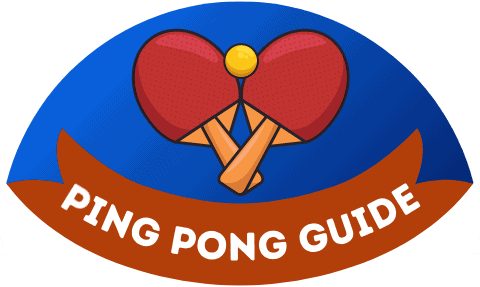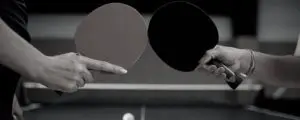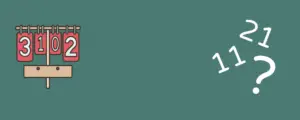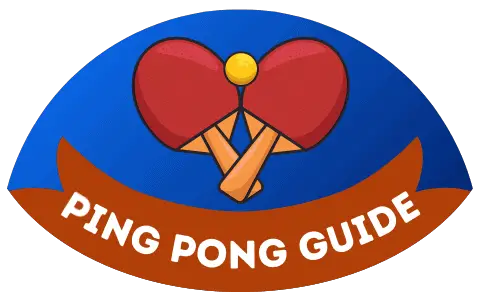You can already tell from the names that table tennis and tennis have a lot in common. But of course, there are also many obvious (and less obvious) differences that make it two clearly separate sports. In this article, I’ll present you with my top 5 differences and similarities.
Post Overview for You
The 5 Biggest Differences Between Tennis and Table Tennis
1. The Cost – Tennis is More Expensive and Therefore Less Accessible.

A big advantage of table tennis over traditional tennis is the cost required to play in the first place. At the same time, table tennis is the cheaper sport overall. The lower cost makes table tennis a more financially accessible alternative to tennis.
In terms of costs, a distinction can be made between the equipment and playing costs:
Equipment costs
Equipment Cost of Table tennis
The cost of bats and balls varies, of course, depending on one’s own requirements. If you just want to play, you can get a table tennis set with 4 bats and 6 balls for $24. Of course, these bats are then only suitable for casual play.
If you are a beginner with more ambitions, you should buy a solid allround bat. These cost about $40-60. For real professional rackets, you have to dig a little deeper into your pocket. Here the costs are about $150-400.
Good table tennis balls are very affordable. It is therefore worthwhile to go directly to the certified 3-star balls. This set of 24 is available for $17.
Equipment Cost of Tennis
Here, too, the costs vary, of course, depending on the level. Basically, you can get a set of rackets with balls for about $60. A good single all-round racket is around $80-100, while for real competition rackets you should plan on $200-500+.
Tennis balls are a bit more expensive than table tennis balls. A set of 3 balls, e.g. from Head or Dunlop costs about $10.
Table Tennis vs. Tennis – Cost of play
When it comes to the cost of rackets, table tennis and tennis do not differ that much. However, the difference is greater when it comes to the cost of actually playing.
While you can find table tennis tables in city parks, residential complexes, or playgrounds for free, you have to rent a court to play tennis. The costs for this are usually around $15-30 per hour maybe even more. If you want to play tennis a lot and intensively, you will have to dig deep into your pocket over time.
Of course, there is also the option to join a club. The costs for it amount on average to approx. $200-250 in the year for tennis and $80-100 a year for table tennis.
If you don’t want to play in public or in a club, you still have the option to play at home. A solid hobby table tennis table costs about $300-500. The cost to build your own tennis court is of course an enormously higher cost, so I will not go into it further 😁.
2. The Dimensions – Tennis is Bigger in Every Aspect.
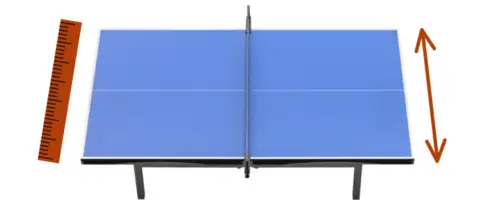
Considering that table tennis was born from the idea of bringing the popular sport of tennis indoors, it’s only logical that the scale of the new game is much smaller. Here is a comparison of the main sizes:
| Size | Tennis | Table Tennis |
| Field (width) | Single: 27 ft / 8,23 m Doubles: 36 ft / 10,97 m | 5 ft / 1.525 m |
| Field (length) | 23,77 m | 2.5 ft / 2.74 m |
| Net height | 2.95 ft. / 0.9 m | 6 in / 15.25 cm |
| Racket length | 29 in / 73,7 cm | ca. 10 in / 24-26 cm |
| Racket width | ca. 12.4 / 31.7 cm | 5.9 in / 15 cm |
| Racket weight | 285 – 310 g | 170-200 g |
| Ball diameter | 2.57 in / 6.54 cm | 1.57 in / 4 cm |
| Ball weight | 56.7-58.5 g | 2.7 g |
The comparison shows well that table tennis is actually the little brother of tennis in every scale.
3. The Technique
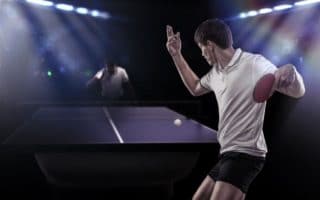
Although the two sports are closely related, as just mentioned, there are significant differences in the technique of hitting the ball. In fact, many table tennis coaches recommend not to play tennis, because otherwise, you will acquire the wrong technique.
Of course, there are many different hitting techniques in tennis and table tennis, but just by looking at the basics, you can see how they differ. So where are the differences?
Stroke techniques in table tennis
The basics are the same in both sports there are:
- forehand: topspin and backspin
- backhand: topspin and backspin
In table tennis it is also extremely important to hit from the whole body and to play more powerful balls by shifting the weight, but most of the movement comes from the forearm.
For example, in the forehand topspin, you turn your body in and move your arm over the ball. However, it is important that the elbow remains fixed for the most part.
Also with the backhand, the stroke movement comes mainly from the forearm and torso.
The situation is different for strokes with an undercut or side cut. In table tennis, a quick movement from the wrist is needed to cut the ball.
Stroke techniques in tennis
In tennis, the whole body is really needed for forehand and backhand – much more than in table tennis. This is also due to the fact that the ball can develop a completely different force due to its higher weight.
The movement here comes from the entire arm, from the shoulder area, and by turning the body in and then shifting the weight.
The whole stroke process usually has a larger scope in tennis. This means that the swing is extended further and the movement is continued after contact with the ball.
For a slice or backspin ball, the movement comes mainly from the entire forearm and not from the wrist.
4. The Counting Method – And with it the Length of the Match
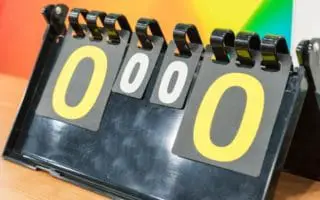
Although table tennis originated from the original tennis sport, the counting method is completely different. Only in the general structure, the two sports are similar: you have to win a certain number of sets to win the match. The structure of a set, however, is completely different. Let’s have a look at it.
Counting in Table Tennis
Depending on the match, you either need 3 (“best of five”) or 4 (“best of seven”) sets to win.
A set goes to 11, but the set must be won with at least 2 points difference. Therefore, if the score is 10:10, it goes to 12, if it is 11:11, it goes to 13, and so on, until one of the players leads by 2 points.
Counting in Tennis
Besides the set and the match, there is an even smaller unit in tennis: The game. The structure is known, for example, from the call of the umpires when a player has won: “Game, Set, Match”.
- Match: Depending on the competition, tennis requires 2 (“best of three”) or 3 (“best of five”) sets to win the match.
- Set: To win a set, you usually need to win at least 6 games. As in table tennis, the same applies here: You have to lead by 2 games difference to win a set for yourself, e.g. 6:4 (7:5 is also possible). An exception is when the score is 6:6 games. Here it comes to the tie break, a “small set” up to 7 points (2 points lead). Whoever wins the tie break wins the entire set 7:6.
- Game: The counting of the game is very special in tennis. Basically, the player who first reaches 4 points with a 2-point lead wins the game. However, it is not counted as 1,2,3,4 but:
- 0 points: “Love”
- 1 point: 15
- 2 points: 30
- 3 points: 40
- 4 points: Game
- Exception: Of course, there is one exception again and it is related to the tie: if the score is 40:40 in a game, the players need 2 points in a row to win the game. After the first point, the player has “Advantage”. If he wins the next point, he wins the game (“Game”), if not the score goes back to 40:40 (Deuce).
Although I really tried to break down the counting to the most necessary, you can easily see that the game structure in tennis is much more extensive and complex than in table tennis.
Duration of a Match
Fitting to the theme: “Everything is bigger in tennis”, the matches also last longer. This is partly due to the counting method just shown, but also because the rallies simply take longer than in table tennis due to the greater distances.
Average match duration
In table tennis, a set up to 11 lasts a maximum of 10 minutes. This is even limited by a rule. So a normal match usually lasts about 20-60 minutes. Of course, this also depends on whether there are 3 or up to 4 winning sets.
Tennis matches, on the other hand, can last many times longer – the record for a competitive match is even 11 hours and 5 minutes! This is of course the exception.
On average, tennis matches last about 90 minutes (“best of three”) or 2 hours and 45 minutes (“best of five”).
5. Volleys – No ‘Serve and Volley’ in Table Tennis
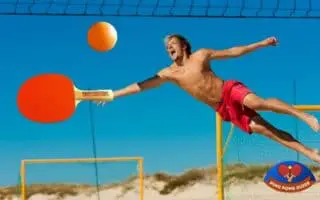
A big and important difference concerns volleys, i.e. balls played directly out of the air. In tennis, it is common to stand close to the net and take the balls directly before they touch the ground. The well-known strategy ‘serve and volley’, where players run directly to the net after their strong serve in order to take the opponent’s usually weak return directly out of the air, is even based on this.
In table tennis, however, volleys are not allowed. The ball may only be played after it has touched the surface of the table.
Let’s look at the corresponding rules:
Rule 2.5.8 states:
“A player obstructs the ball if he or she, or anything he or she wears or carries, touches it in play when it is above or traveling towards the playing surface, not having touched his or her court since last being struck by his or her opponent.”
So this is where table tennis clearly differs from its big brother.
The 5 biggest Similarities Between Table Tennis and Tennis
After the differences, let’s now look at the similarities between the two racket sports. Of course, just by the fact that table tennis evolved from tennis, there are some aspects where there are similarities. Here are my top 5:
1. Origin – Both Sports Originated in England.
The sports as we know them today originate from England and were initially popular sports among the upper class and the nobility. According to history, the original form of tennis originated in northern France, but today’s lawn tennis comes from Great Britain and was invented there in the 1870s.
Interestingly, table tennis also has its beginnings in this period. So it wasn’t long before people came up with the idea of bringing tennis indoors in smaller dimensions. One reason for this is said to have been the well-known rainy English weather.
At first, the game was not called table tennis, but ping pong. This was the name of the first official association, which was founded in 1902 Ping Pong Association. Important: Meanwhile, table tennis and ping pong are officially different sports with different competitions.
2. Similar Skillset Required
Due to the similarities between table tennis and tennis, both games require similar skills. Here is a short list of skills that are important in both sports.
1. Hand-eye coordination
Good hand-eye coordination is elementary to hit the ball correctly and return it placed to the other side. The eyes should be focused exclusively on the ball.
The stroke movement with the arm or hand happens more or less automatically.
2. Reaction speed
In both sports it is important to react quickly to the opponent’s balls. Whether it is getting into position as quickly as possible or blocking a smash with a short reaction time.
Reaction time is a key factor in both tennis and table tennis about how good a player is.
3. Strong nerves needed
Unlike sports with large teams, you are usually on your own. In doubles, you still have a partner, but even here, the pressure during the match is shared between two shoulders, not eleven or even more.
Therefore, nerves of steel are often crucial in table tennis and tennis. Especially in matches where the players are relatively on the same level, the mental aspect makes the difference.
Only players who can perform well under pressure and don’t suddenly make a lot of simple mistakes make it to the top.
4. Applying and recognizing spin
Spin is an extremely important aspect of both table tennis and tennis. The different rotations of the ball provide variability in the game. While topspin balls are good for attacking and easily end up out of bounds on the return, backspin is ideal for short and defensive balls. These tend to go into the net on the return stroke.
As a tennis or table tennis player, it is therefore important to be able to master and recognize the different types of spin.
3. Common Rules
Because tennis is the forerunner of table tennis, both racket sports naturally have many rules in common:
1. Basic rules
These include, for example, that each player may only touch the ball once or that the ball may only hit the ground or the table once in both tennis and table tennis.
Another example would be the ball touching the net: Net rolls are legal as long as the ball lands in the opponent’s court. If this is not the case or if the ball simply lands in the net, the opponent gets a point.
This also makes the scoring of a point very similar in both sports showing that both games have their similarities.
2. Net roll on serve
There are also similarities in the serve. Of course, the serve is executed differently in tennis and table tennis. Before the rules were changed, you had to serve diagonally in table tennis. But this is no longer the case.
What is the same, however, is the handling of net rolls during the serve. In both games, the serve is repeated.
3. Counting in case of a tie
Above I have already explained in detail how the counting differs between the two sports. However, there is one aspect where tennis and table tennis are similar: The counting method during a tie.
During a tennis match or table tennis set, players must each have at least a 2-point lead to win. Even the sets in tennis, with the exception of the tie break, are decided with at least a 2 set lead.
4. Similar dynamics and situations during the match
What do I mean by this? Tennis and table tennis are basically very similar: 1-2 players who have to play the ball over the net into the opponent’s half with only one racket contact.
Very fundamentally, similar situations occur here during the match. Here are a few examples:
- Extremely long rallies
- Net rolls and lucky points
- Offensive versus defensive play
The fact that both are mostly single sports also plays a role for me. Because so the individual players are completely dependent on themselves. Any slight insecurity or gained self-confidence is immediately noticeable. So nerves or mental abilities play a decisive role here.
Thus, during the games, similar dynamics occur. Here are a few examples:
- Players blow several match points, lose their confidence completely and lose in the end.
- Or the other way around: A small action (e.g. a good smash) gives a player new security.
Often the momentum changes several times in the match.
5. The Same Game Modes (Singles, Doubles, Mixed)
The last commonality in my list is the game modes. In both tennis and table tennis there are:
- Singles: So the traditional 1 against 1
- Doubles: 2 against 2
- Mixed: 2 against 2 with one woman and one man in each team
In both sports, the counting method does not change when doubles are played instead of singles, but there are still a few differences:
- Table tennis: Here you have to serve diagonally when playing doubles. In addition, the rotation is in a certain order.
- Tennis: Here the entire playing surface is enlarged. In doubles, the outer lines of the court are the boundaries.
Table Tennis vs. Tennis – Frequently Asked Questions
I hope I could explain you the differences and similarities of tennis. You still have questions? No problem! Here are some answers to frequently asked questions about tennis and table tennis.
Which is more exhausting – table tennis or tennis?
The short answer is: tennis. But of course, you have to differentiate. It always depends on the intensity with which a sport is performed in order to be able to make a statement about how strenuous it is.
If I were to play an hour of tennis and an hour of table tennis with the same intensity, I would burn almost twice as much energy playing tennis (table tennis: 295 Kcal vs. tennis: 577).
This is not surprising, because the dimensions of tennis are different. The ball and the racket are heavier and the field is also larger. Furthermore, if you compare the physical exertion during official matches, tennis matches also last much longer.
But that doesn’t mean that table tennis can’t be a good workout. Professionals burn far more than 600 calories playing table tennis.
For your information, if you want to check for yourself how many calories you would burn doing these sports, you can visit captaiptaincalculator.com::
Tennis vs. table tennis Which Sport came first?
The answer here is quite clear: tennis. As already mentioned, table tennis originated from lawn tennis in England at that time.
Which is faster – Table Tennis or Tennis?
Here it depends on how you understand the question: The speed of the ball or the stroke frequency of the game?
Ball Speed
Here, tennis is clearly ahead. While in table tennis, the fastest measured ball is only 72 mph (116 Km/h) (according to the Guinness Book of Records), tennis balls in professional matches often reach over 125 mph (200 Km/h) on serve alone. The record here even is 144.78 mph (233 Km/h).
Stroke Frequency
Here table tennis is clearly the faster sport. Because of the much smaller playing surface, the ball goes back and forth much more often and the players also have a much shorter reaction time.
Are Table Tennis Players Good Tennis Players (& vice versa)?
Due to the fact that the hitting techniques in both sports, as described above, are very different in execution (in tennis more from the shoulder vs. in table tennis more from the forearm and wrist), it is said that the two sports do not get along at first.
This means that a very good tennis player is not automatically good at table tennis and vice versa. At the same time, of course, this doesn’t mean that you can’t master both sports.
But no matter if you are already a good player or just starting out. The most important thing is this:
The fun of the game 🏓
